|
The Mysterious Antikythera Mechanism
by Gary Vey
In 1900 a sponge diver was working in the Mediterranian, just off the island of Antikythera at a depth of about 138 feet. Divers had noticed various fragments of ancient cargo scattered along the bottom of this location but it was one Elias Stadaitos who discovered the source of these artifacts. Elias found the remains of a Roman cargo ship and for many months he returned to the site to find statues, pottery and interesting clumps of rock which often encrusted metalic objects.
The original piece of rock was about 13 inches high, 7 inches wide and only 3 inches thick, leading many to speculate that it was probably just a piece of a much larger mechanism. There were also symbols etched in the metal which later were shown to be Greek. Although difficult to date, the strange artifact was thought to be over two thousand years old, making it one of the earliest precision geared devices in existence. The fine teeth of the gears suggested it was some type of clock mechanism, but the complexity of the pieces also suggested that it was designed to do more than tell the time of day. The artifact, which became known as "the Antikythera Mechanism" was largely unknown for many decades as it was meticulously cleaned. In 1951 when the encrusted rock had finally been cleared to reveal the badly eroded gears, a British scientist named Derek Price began a comprehensive study of the devices function and probably use. The Antikythera Mechanism gained world attention when it was the cover story in Scientific American (June 1959) and was later exposed to the general public by Arthur Clarke's book Mysterious World. In Clarke's book he described the mechanism as "the world's first computer" and suggested that was capable of calculating the position of the stars and planets. This was largely disputed by historians who reminded the world that "planets" were only a vague concept of scholars around the time of Copernicus in the sixteenth century!
In 1971, Price joined forces with Charalampos Kararalos, professor of nuclear physics at the Greek National Center of Scientific Research and devised a way to x-ray the rock with powerful gamma rays. Their experiment was very successful and revealed additional gears which were critical in understanding how the mechanism functioned.
Although the device was analog (mechanical) it could calculate with the accuracy of a slide rule. It plotted angular velocities, the synodic and sideral lunar cycles, and presented the position of the known planets and moon for any date entered. Aside from being an engineering mystery, the device showed that the designers understood that the sun was the center of the local system -- not the Earth! This view would later be worthy of imprisonment or even death by the geocentric Roman Catholics of later centuries. Other functions provided by this device were described as:
More Recent Investigations
London based scientists Michael Wright and Allan Bromley subjected the Antikythera Mechanism to tomographic scans and discovered that the hidden gears were actually configured differently from those theorized by Price. They then began an antirely new reconstruction of the device based on this more acurate information. He showed that the device was capable of much more than had previously been imagined.
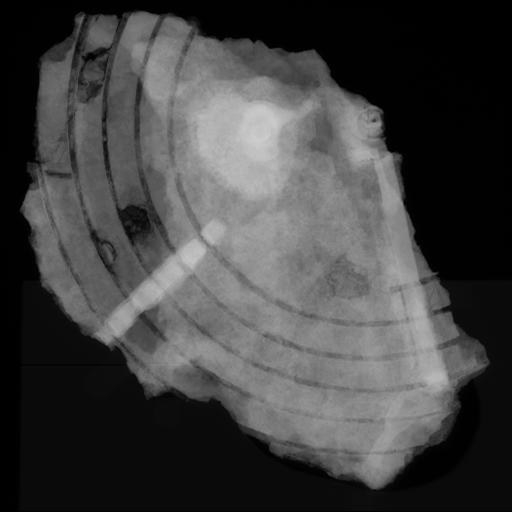 [Above: actual 3-d image obtained by Wright and Bromley] On November 30, 2006, the journal Science published a new reconstruction of the mechanism based on the high resolution tomography conducted by Wright and Bromley. Their work doubled the amount of readable characters and corrected previous translations. It was also announced that other small fragments of the device had been found and incorporated in to the new reconstruction. The latest work confirms that the device was an astronomical computer or "orrey" used to predict the positions of heavenly bodies in the sky.
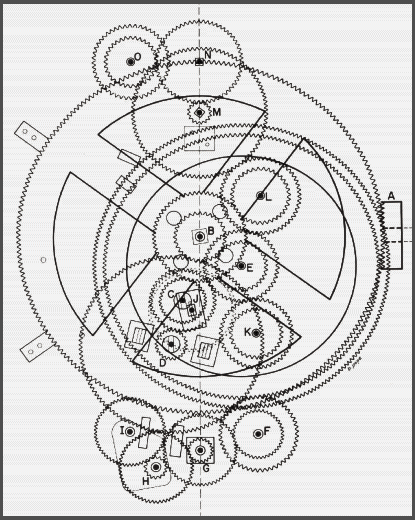 [Above: more complete mechanical schematic of the device obtained by 3-d imaging.] The device consists of 37 gears, of which 30 still survive. On the front face there were graduations showing the solar cycle and the zodiac with pointers shopwing the position of the sun and moon and also indicating the lunar phase. On the bgack of the device there was a dial showing the progress of the Saros cycle (a cycle of 18 years during which the sun, moion and earth return to their relative positions in space) and the Callippic cycle (a cyclical calendar of 76 years devised by Callipus in 330 BC. and perhaps still used during the time of the Antikythera Mechanism).
 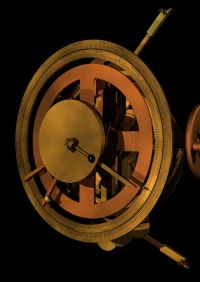 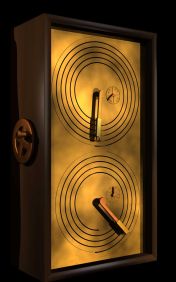 [Above: recent reconstruction showing the front (left) and back (right) panels of the device and inner gears (center).] Press Release fron NATURE (November 2006) An ancient astronomical calculator, built around the end of the second century BC, was unexpectedly sophisticated, a study in this week's Nature suggests. Mike G. Edmunds and colleagues used imaging and high-resolution X-ray tomography to study fragments of the Antikythera Mechanism, a bronze mechanical analog computer thought to calculate astronomical positions. The Greek device contains a complicated arrangement of at least 30 precision, hand-cut bronze gears housed inside a wooden case covered in inscriptions. But the device is fragmented, so its specific functions have remained controversial. The team were able to reconstruct the gear function and double the number of deciphered inscriptions on the computer's casing. The device, they say, is technically more complex than any known device for at least a millennium afterwards. The text is astronomical with many numbers that could be related to planetary motions, and the gears are a mechanical representation of a second century theory that explained the irregularities of the Moon's motion across the sky caused by its elliptical orbit. CONTACT Mike G. Edmunds (Cardiff University, UK).
|

Other history related articles on this site:
.
.
.
.
.
.
.
.
.
.
.
.
If you have a suggestion or history related article to submit, send it to:
Editor/viewzone.com
myristicin@hotmail.com
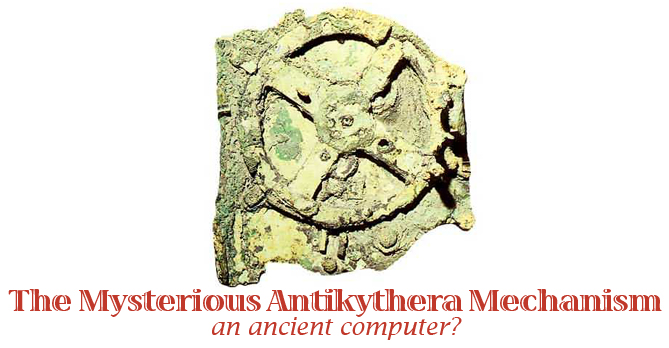
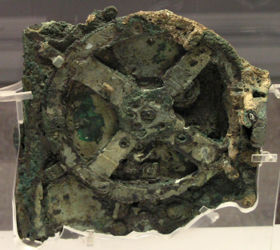 In May of 1902 an archaeologist named Valerios Stais noticed that one piece of interesting rock seemed to have what looked like a gear wheel embedded in it and set the piece aside for further inspection.
In May of 1902 an archaeologist named Valerios Stais noticed that one piece of interesting rock seemed to have what looked like a gear wheel embedded in it and set the piece aside for further inspection.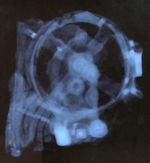 [Right: first x-ray of artifact.] Although the mechanism has been cleaned, many of the gears were believed to remain encrusted and corroded in the remaining stone. To chip away at this stone would certainly destroy any traces of the gears that remained. Scientists looked for other methods to "see" inside the remaining rock and to determine the full extent of the gears.
[Right: first x-ray of artifact.] Although the mechanism has been cleaned, many of the gears were believed to remain encrusted and corroded in the remaining stone. To chip away at this stone would certainly destroy any traces of the gears that remained. Scientists looked for other methods to "see" inside the remaining rock and to determine the full extent of the gears.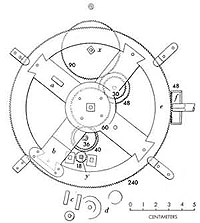 [Left: first attempt to draw a mechanical schematic based on x-rays] In 1974 Price published "Gears from the Greeks -- the Antikythera mechanism -- a calendar computer from circa 80 B.C." and illustrated a schematic of how the devide probably functioned. Scientists from around the globe were surprised at the miniturization of the gears -- similar to work of fine watchmakers centuries later! It was also highly complex, suggesting that the fundamental knowledge of mechanics was well advanced.
[Left: first attempt to draw a mechanical schematic based on x-rays] In 1974 Price published "Gears from the Greeks -- the Antikythera mechanism -- a calendar computer from circa 80 B.C." and illustrated a schematic of how the devide probably functioned. Scientists from around the globe were surprised at the miniturization of the gears -- similar to work of fine watchmakers centuries later! It was also highly complex, suggesting that the fundamental knowledge of mechanics was well advanced. 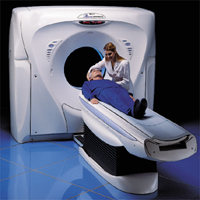 In the 21st Century, imaging techniques have greatly improved. We can now scan objects in 3-dimentions with CAT scans (Computer Assisted Tomography) and receive a higher resolution than with x-ray techniques. [Right: A patient about to undergo a CAT scan. Most of these improvements in imaging have been employed in medicine, to detect cancer or other pathologies.]
In the 21st Century, imaging techniques have greatly improved. We can now scan objects in 3-dimentions with CAT scans (Computer Assisted Tomography) and receive a higher resolution than with x-ray techniques. [Right: A patient about to undergo a CAT scan. Most of these improvements in imaging have been employed in medicine, to detect cancer or other pathologies.]